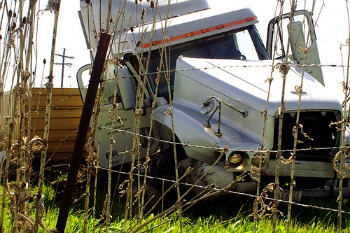DON JERRELL
Associate Vice President
 We’ve found that most transportation companies offer little to no training for drivers on what to do after an accident occurs. Training typically focuses on preventing accidents (which is clearly important). But stopping there leaves out a critical component.
We’ve found that most transportation companies offer little to no training for drivers on what to do after an accident occurs. Training typically focuses on preventing accidents (which is clearly important). But stopping there leaves out a critical component.
When your driver hears the screech of tires and the wail of sirens, you don’t want him flying by the seat of his pants. Training drivers on what to do at an accident scene can go along way toward preventing a claim from spiraling into one of the multi-million dollar judgments we’ve all seen in the news recently.
Train drivers on easy-to-remember steps, and make sure there's a cheat sheet in the cab that covers the steps. After an accident, a well-trained driver must:
Step 1. Remain Calm
In an accident, the driver is a professional on the scene. He is still on duty and has an obligation to remain calm and cool — no matter how the other party behaves. Drivers should never admit fault on the scene or apologize (this can be twisted into an admission of guilt by a prosecutor). While your driver certainly will feel bad, reinforce that who’s at fault and who has liability will be determined following a full investigation.
Step 2. Stop
Drivers should leave their vehicle as-is unless instructed to do otherwise by police or by posted signs. If there is an injury, drivers sometimes have the instinct to use their vehicle to block the scene. A unit should NEVER be used to shield the scene — because if another car comes up and hits your driver's vehicle, your company will be held liable.
Step 3. Secure the scene
Failure to secure the scene properly can result in major liability. The law says if your vehicle is stopped for more than 10 minutes, you need to put out reflectors. That doesn’t mean wait 10 minutes to put them out — it means you put them out as soon as possible when you know you’re going to be stopped.
FMCSA regulations set the following requirements for reflector placement:
Non-Divided Highway:
a. One reflector 100 feet in front of the unit.
b. One reflector 10 feet behind the unit.
c. One reflector 100 feet behind the unit.
Divided Highway:
a. One reflector 10 feet behind the unit.
b. One reflector 100 feet behind the unit.
c. One reflector 200 feet behind the unit.
Step 4. Get help and help the injured
Once stopped and the scene is secure, the biggest priority is helping the injured. If witnesses stop, instruct the drivers to ask several people to call or drive to seek help.
It’s also important to teach drivers about blood-borne pathogens and how to respond if they encounter blood. Drivers should have plastic gloves and a basic first aid supplies in the truck.
Step 5. Get witness information
For witnesses at the scene who are willing to give their information, get their name, address, phone number, and license plate number. Drivers should try to do this as quickly as possible before people leave or become intimidated by the situation.
Frequently, people who saw the accidnet aren’t too eager to be witnesses. If they don’t want share their information, the driver shouldn't press the issue. Take a picture of their license plate and revisit the information if needed.
How the driver conducts himself at the scene can have a major impact on whether a bystander is a witness for or against you. Drivers must be courteous, take down witness information, and move on.
Step 6. Notify your company
Drivers must be prepared to notify the company immediately and know who to call. In some cases, drug testing may be required following an accident, either by the DOT or your insurance company. A driver must make an effort to get tests for both drug and alcohol use within two hours. If tests cannot be taken within two hours, the company must document the reason for the delay and keep trying (and documenting) for up to eight hours for the alcohol test and up to 32 hours for the controlled substance test.
Step 7. Present a neutral and definitive explanation
When talking to the safety department, the first words out of a driver's mouth following an accident typically are, “It wasn’t my fault.” Ask drivers to tell you honestly what happened and ask as many questions as you can to get to the truth.
A good probing question is, “If you were the other party, what would you say to try to put the blame on us?” This often helps get at what really happened.
Step 8. Take Photos
Equip your vehicles with disposable cameras, although most drivers can use a camera in their cell phones. Instruct them to take photos of all four sides of vehicles involved in the accident, every time. Out of respect, don't take photos of injured or deceased parties.
A Bold Idea in Post-Accident Training
Make these steps part of your driver orientation, and provide in-cab cheat sheets for the day you may need them. One company we’ve worked with even staged crash scene at its training facility. At the faked accident, drivers did a walk-through of the steps they would need to perform. This low-risk practice can help a driver recall these eight steps when they need them!
How do you talk to your drivers about post-crash actions? Please sound off in comments. If you need help bringing your drivers up to speed on what to do after a crash, download our sample training slide deck (button below) to make sure you drive home the vital points.
DISCLAIMER: We hope this blog post gave you an "Aha!" moment, but please don't hold it as legal or tax advice. This information is general in nature, and your specific situation deserves attention from a dedicated legal or tax advisor.
Related Posts:
5 Things Drivers Never Should Do at the Scene of an Accident
Legal Landmines in the Trucking Industry: Are You Protected?
Understanding Roadside Violations: The Key to Motor Carriers' Legal Defense
How Motor Carriers Can Avoid Getting Sued
.png?width=69&height=53&name=Acrisure%20Logo%20(White%20Horizontal).png)


